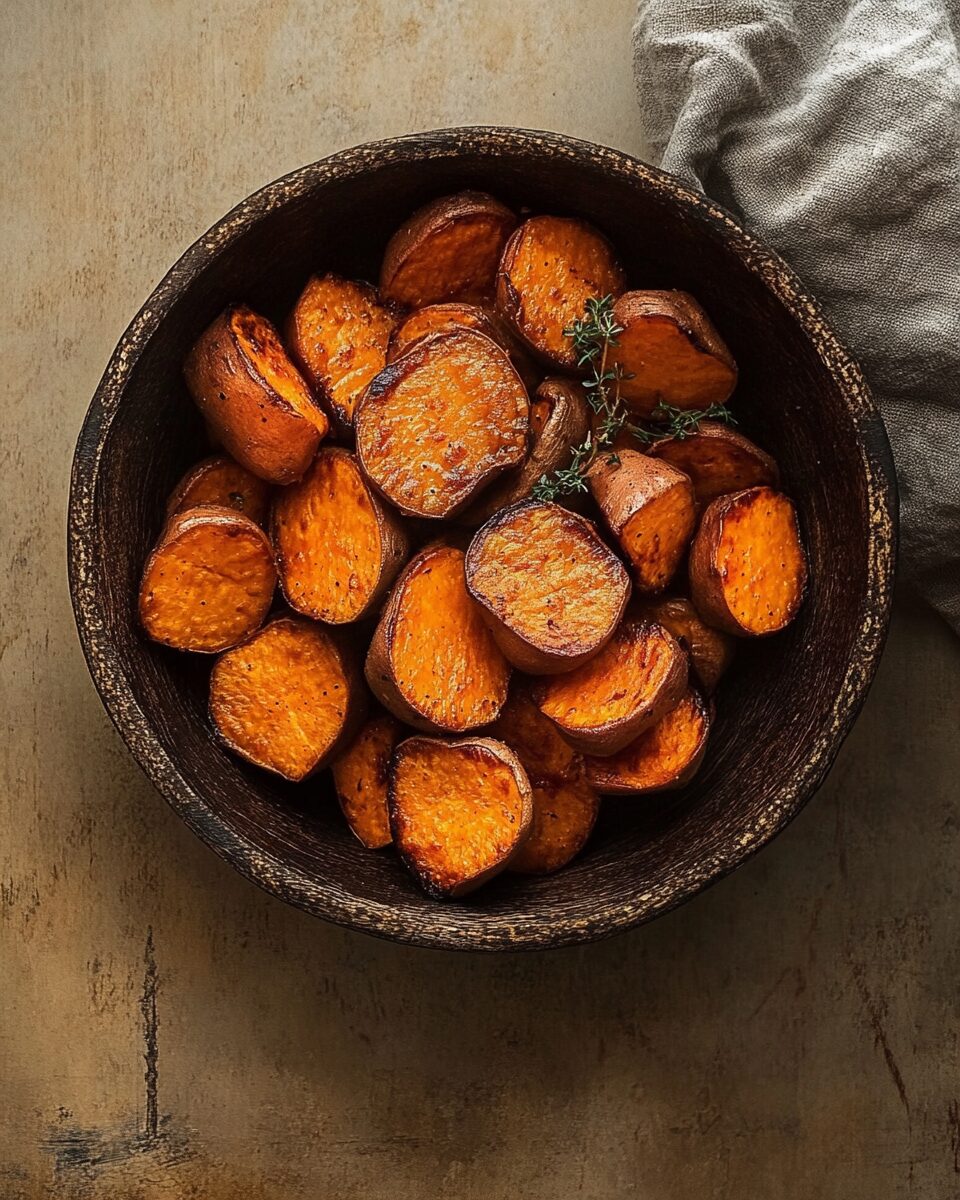Roasted sweet potatoes with a combination of sweet and savory flavors create a perfect side dish for any meal. With a simple seasoning mix and a crispy exterior, these sweet potatoes offer a delightful contrast in texture and taste.
FULL RECIPE
Ingredients
- 4 medium sweet potatoes, peeled and cubed
- 2 tablespoons olive oil
- 1 tablespoon maple syrup
- 1 teaspoon cinnamon
- 1/2 teaspoon smoked paprika
- 1/4 teaspoon sea salt
- 1/4 teaspoon black pepper
- 1 tablespoon fresh parsley, chopped (optional)
Directions:
- Preheat the oven to 400°F (200°C).
- In a large bowl, combine olive oil, maple syrup, cinnamon, smoked paprika, salt, and pepper.
- Add the cubed sweet potatoes to the bowl and toss to coat evenly with the seasoning mixture.
- Spread the seasoned sweet potatoes on a baking sheet in a single layer.
- Roast for 25-30 minutes, turning halfway through, until the sweet potatoes are golden and tender.
- Remove from the oven and sprinkle with fresh parsley, if desired. Serve hot.
Nutritional Information
- Calories: 150 per serving
- Carbohydrates: 34g
- Protein: 2g
- Fat: 2g
- Fiber: 5g
- Sugars: 9g
- Sodium: 150mg
History and Origins of Sweet Potatoes
Sweet potatoes have a long and fascinating history. They were first cultivated over 5,000 years ago in Central and South America, with evidence of their cultivation found in ancient Peru. These nutritious tubers were a staple for indigenous populations, and their popularity spread across the globe after European explorers discovered them. Today, sweet potatoes are grown in many regions and are enjoyed by people worldwide due to their versatility and nutritional value.
Health Benefits of Sweet Potatoes
Sweet potatoes are packed with essential nutrients. They are an excellent source of Vitamin A, thanks to the high levels of beta-carotene they contain. This antioxidant supports healthy vision and boosts the immune system. In addition to Vitamin A, sweet potatoes are high in fiber, which aids digestion and helps regulate blood sugar levels. The antioxidants present in sweet potatoes also help reduce inflammation and fight oxidative stress, benefiting overall health.
Sweet vs. Regular Potatoes: What’s the Difference?
While sweet potatoes and regular potatoes belong to the same plant family, they are not the same. Sweet potatoes are typically sweeter, richer in nutrients like Vitamin A, and have a more vibrant color, ranging from orange to purple. Regular potatoes, on the other hand, tend to have a higher starch content and a more neutral flavor. Sweet potatoes are often considered the healthier option due to their higher nutrient density, especially in terms of antioxidants and vitamins.
How to Choose the Best Sweet Potatoes
When selecting sweet potatoes, look for ones that are firm with smooth, unblemished skins. Avoid those with wrinkles, cracks, or signs of decay. The skin should be intact and free from dark spots, and the flesh should feel dense for its size. Opt for smaller to medium-sized sweet potatoes, as larger ones may be fibrous and less flavorful. Choose ones with deep orange or purple hues, as they generally have a richer flavor and more nutrients.
Storage Tips for Sweet Potatoes
Proper storage can significantly extend the shelf life of sweet potatoes. Store them in a cool, dark, dry place like a pantry or cupboard, avoiding the refrigerator. The cold temperature can alter their texture and taste. Keep them in a well-ventilated container, such as a basket or mesh bag, to prevent moisture buildup. When stored correctly, sweet potatoes can last up to a month. Once cooked, store them in the refrigerator for up to a few days.
Sweet Potato Varieties
There are several varieties of sweet potatoes, each offering a unique flavor and texture. The most common variety is the orange-fleshed sweet potato, which has a sweet, creamy texture when cooked. Purple sweet potatoes are a bit firmer and have an earthier flavor. White-fleshed sweet potatoes are starchier and less sweet, making them perfect for savory dishes. Japanese sweet potatoes, with their nutty flavor and purple skin, offer a unique option for those looking for something different.
Roasting vs. Boiling Sweet Potatoes
Roasting and boiling are two popular methods for cooking sweet potatoes, each offering distinct results. Roasting sweet potatoes caramelizes their natural sugars, producing a rich, deep flavor and crispy exterior. Boiling, on the other hand, results in a soft, delicate texture, making it ideal for mashed sweet potatoes. While boiling preserves more of the Vitamin C content, roasting enhances the flavor, concentrating the nutrients and creating a more savory or sweet profile.
Sweet Potato Recipes for Every Meal
Sweet potatoes are incredibly versatile and can be used in many different dishes. They can be roasted, mashed, grilled, or baked. Try adding roasted sweet potatoes to salads, grain bowls, or even tacos. For breakfast, make a sweet potato hash or add them to oatmeal for extra fiber and nutrients. Sweet potatoes also shine in soups, stews, and casseroles. Of course, they are also a key ingredient in many desserts, such as sweet potato pie and brownies.
Sweet Potatoes in Traditional Cuisines
Sweet potatoes feature prominently in many traditional cuisines around the world. In Southern American cooking, they are used in casseroles, pies, and fries. In African and Caribbean cuisines, sweet potatoes are often boiled, roasted, or fried, sometimes seasoned with cinnamon, nutmeg, or chili. In East Asian cooking, they are added to both savory dishes like soups and sweet dishes like pastries and desserts. Their global popularity speaks to their versatility in cooking.
The Role of Sweet Potatoes in Sustainable Eating
Sweet potatoes are an environmentally friendly food choice, as they are relatively easy to grow and require less water than other crops like rice or wheat. They are also resistant to pests, reducing the need for chemical pesticides. By incorporating sweet potatoes into your meals, you support sustainable agriculture practices and help promote a more eco-friendly food system. Their resilience in a variety of climates also makes them an excellent crop for global food security.
Cooking Sweet Potatoes with Different Seasonings
Sweet potatoes are a perfect blank canvas for a wide range of seasonings. For savory dishes, try combining them with garlic, rosemary, thyme, or paprika. A sprinkle of cumin or chili powder can add an interesting depth of flavor, while cinnamon, nutmeg, and maple syrup are excellent choices for sweeter dishes. Experimenting with different spice blends can transform sweet potatoes into a unique dish every time.
Sweet Potatoes and Weight Loss
Despite their natural sweetness, sweet potatoes can be a great food choice for those looking to lose weight. They are low in calories but high in fiber, which helps keep you full longer. The fiber in sweet potatoes also supports digestion and helps regulate blood sugar levels. Because they have a low glycemic index, sweet potatoes provide a slow, steady release of energy, helping to avoid sugar spikes and crashes. This makes them an excellent addition to a balanced weight loss diet.
Sweet Potatoes in the Keto Diet
While sweet potatoes are not typically considered keto-friendly due to their higher carbohydrate content, they can still be enjoyed in moderation. For those following a low-carb or ketogenic diet, small portions of sweet potatoes can be a great way to add variety and nutrition without completely derailing carb intake. Pairing them with protein-rich foods like chicken or fish can help balance out the overall macronutrient profile of the meal.
Vegan and Gluten-Free Recipes with Sweet Potatoes
Sweet potatoes are naturally both vegan and gluten-free, making them a perfect ingredient for plant-based and gluten-free diets. You can use them in a wide variety of savory dishes like soups, stews, and roasted vegetable bowls. They also work wonderfully in baked goods such as muffins, cakes, and pancakes, offering a healthy and gluten-free alternative to traditional recipes. Their creamy texture makes them a great substitute in vegan recipes for dishes like mashed potatoes or creamy sauces.
Creative Sweet Potato Desserts
Sweet potatoes make for excellent dessert ingredients due to their natural sweetness and creamy texture. Sweet potato pie is a classic dessert in many parts of the world, flavored with spices like cinnamon, nutmeg, and vanilla. You can also use sweet potatoes in cookies, brownies, or cakes for a healthier twist on traditional sweets. Their unique flavor also works well in pies, puddings, and even ice cream, making them a delicious and nutritious dessert option.
The Impact of Roasting on Nutrients
Roasting sweet potatoes brings out their natural sweetness and enhances their flavor. However, this cooking method does affect their nutrient content. Roasting can cause some vitamins, particularly Vitamin C, to degrade. But roasting sweet potatoes at a moderate temperature helps concentrate the beneficial nutrients like fiber and antioxidants, giving you a nutrient-dense dish. To preserve the most nutrients, avoid overcooking them, and use minimal oil or fat during the roasting process.
Pairing Roasted Sweet Potatoes with Other Vegetables
Roasted sweet potatoes pair wonderfully with other vegetables. Try combining them with root vegetables like carrots, parsnips, or beets to create a hearty, satisfying dish. Cruciferous vegetables like broccoli, Brussels sprouts, and cauliflower also work well with sweet potatoes, providing a balance of flavors and nutrients. Mixing different vegetables adds variety, enhances the nutritional value of the meal, and creates a visually appealing dish.
Sweet Potatoes and Bone Health
Sweet potatoes are a great addition to any diet focused on maintaining strong bones. They are rich in manganese, a mineral that plays a crucial role in bone formation and maintenance. In addition, sweet potatoes provide calcium and magnesium, which are vital for bone health. Including sweet potatoes in your meals can help ensure you are getting the nutrients necessary to support bone density and reduce the risk of conditions like osteoporosis.
Sweet Potatoes in Smoothies
Sweet potatoes might not be the first thing you think of when it comes to smoothies, but they actually make a delicious addition. Roasted sweet potatoes can be blended into smoothies to add creaminess and natural sweetness. Combine them with fruits like bananas, berries, and apples, along with a splash of almond milk and some cinnamon for a nutrient-packed, energy-boosting smoothie. This is a great way to get more fiber and antioxidants into your diet.
Conclusion
Sweet potatoes are a highly nutritious and versatile food that can be used in a wide variety of dishes. From savory side dishes to sweet desserts, they are packed with vitamins, minerals, and fiber that support overall health. Whether roasted, mashed, or blended into smoothies, sweet potatoes offer countless ways to enjoy their benefits. By incorporating them into your diet, you not only enjoy their delicious taste but also give your body the nutrients it needs to thrive.






